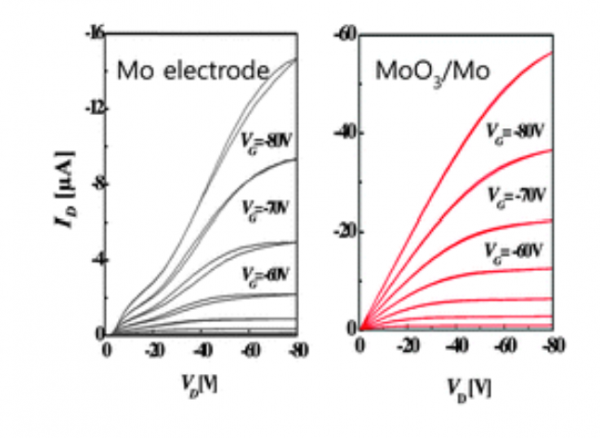Controlling charge injection properties in polymer field-effect transistors by incorporation of solution processed molybdenum trioxide
- 저자
- Dang Xuan Long, Yong Xu, Huai-xin Wei, Chuan Liu*, Yong-Young Noh*
- 저널명
- Physical Chemistry Chemical Physics
- 년도
- 2015
- Link
- http://dx.doi.org/10.1039/C5CP03369A 430회 연결
[Abstract]
A simply and facilely synthesized MoO3 solution was developed to fabricate charge injection layers for improving the charge-injection properties in p-type organic field-effect transistors (OFETs). By dissolving MoO3 powder in ammonium (NH3) solvent under an air atmosphere, an intermediate ammonium molybdate ((NH4)2MoO4) precursor is made stable, transparent and spin-coated to form the MoO3 interfacial layers, the thickness and morphology of which can be well-controlled. When the MoO3 layer was applied to OFETs with a cost-effective molybdenum (Mo) electrode, the field-effect mobility (μFET) was significantly improved to 0.17 or 1.85 cm2 V−1s−1 for polymer semiconductors, regioregular poly(3-hexylthiophene) (P3HT) or 3,6-bis-(5bromo-thiophen-2-yl)-N,N′-bis(2-octyl-1-dodecyl)-1,4-dioxo-pyrrolo[3,4-c]pyrrole (DPPT-TT), respectively. Device analysis indicates that the MoO3-deposited Mo contact exhibits a contact resistance RC of 1.2 MΩ cm comparable to that in a device with the noble Au electrode. Kelvin-probe measurements show that the work function of the Mo electrode did not exhibit a dependence on the thickness of MoO3 film. Instead, ultraviolet photoemission spectroscopy results show that a doping effect is probably induced by casting the MoO3 layer on the P3HT semiconductor, which leads to the improved hole injection.
